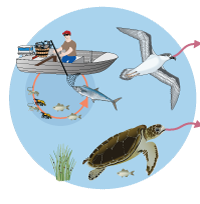|
|
BiologicalAnimals ingest, become entangled by and carry waste. This can both harm animals as well as move the waste through the environment and food chains.
Quick facts
BiologicalThe biological pathway involves waste material being transported by animals, either by physically moving items, or by ingesting waste material and then releasing it in different areas (by defecation, regurgitation or decomposition after death). It includes people walking and dropping litter, as well as animals knocking over bins or scavenging and distributing rubbish. Birds are intelligent and can easily get into bins, stored food and industrial skips, moving waste through the environment. Easy to install solutions can deter crows, ibis and other birds from moving waste. Feral pigs are one of both Queensland’s and Australia’s most significant pest animals[4]. They have been reported to ingest edible (i.e. organic food waste) and non-edible (i.e. paper, plastic bags, nappies) waste from bins and landfills[2]. Studies show that over 1,400 species of marine animals, including marine mammals, sea turtles and sea birds, move waste through the environment by ingesting it. This occurs due to the animals confusing waste with food, or by accidental ingestion while feeding, resulting in death from gastrointestinal blockages, perforation and malnutrition[3].References
Last updated: 23 April 2025 This page should be cited as: Department of Environment, Science and Innovation, Queensland (2025) Biological, WetlandInfo website, accessed 8 May 2025. Available at: https://wetlandinfo.des.qld.gov.au/wetlands/management/pressures/litter-illegal-dumping/pathways/biological/ |

 — Department of the Environment, Tourism, Science and Innovation
— Department of the Environment, Tourism, Science and Innovation


